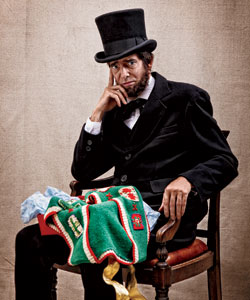
Will Clinger portrays Abe Lincoln in A Civil War Christmas Think Christmas shows, and the usual sugarplummy suspects spring to mind: Santa, Scrooge, Rudolph. The Civil War? Not so much. But with A Civil War Christmas, Northlight Theatre in Skokie hopes to forge a new holiday tradition. “I truly believe this could be the American Christmas Carol,” says B. J. Jones, Northlight’s artistic director.
Jones isn’t alone in his admiration for this music-infused period piece by Paula Vogel, who wrote the 1998 Pulitzer Prize–winning drama How I Learned to Drive. Henry Godinez, the head of Northwestern University’s Theatre and Interpretation Center, had called Vogel about producing the work after seeing a reading of it in April at the Inge Festival in Independence, Kansas, where Vogel was the guest of honor.
“I wanted to do it as a student production,” Godinez says. “When Paula told me Northlight had it, I was disappointed.” But not for long. A fan of Godinez’s work, Vogel suggested him as the director, and Jones agreed. “Henry’s passionate about the show,” Jones says. “[And] he’s got six years of directing [the Goodman’s] Christmas Carol, so he knows how to work an epic-sized ensemble.”
Related:
10 MORE HOLIDAY SHOWS »
for every taste and temperament
In the play, set on Christmas Eve 1864, the lives of more than a dozen characters both historical (Abraham Lincoln, Elizabeth Keckley, John Wilkes Booth) and fictional (an escaped slave, a Jewish Union soldier, a runaway Virginia boy) overlap in at least eight intersecting plot lines. The main stories center on Hannah, a runaway slave who becomes separated from her seven-year-old daughter at the Potomac River; Abraham and Mary Todd Lincoln as they try to find gifts for each other in a nod to “The Gift of the Magi”; and Elizabeth Keckley, a freed slave who turns a talent for sewing into a thriving business making dresses for the elite of Washington, D.C.
With more than 50 roles, A Civil War Christmas requires an army of players. Northlight’s 20-member cast is strikingly diverse, ranging from the Tony nominee Felicia P. Fields to a chorus of Northwestern students and elementary schoolers from the theatre’s training academy. Underscoring the play’s 60-plus scenes is Daryl Waters’s orchestration, a complex sonic tapestry of carols, spirituals, and gospel. “The music is almost internal,” says Fields, the Blue Island powerhouse whose belting, resonant contralto anchored The Color Purple. “It’s like you’re thinking in song and the audience is eavesdropping.”
Vogel tapped into her own musical roots in writing the play. “As a teenager, I’d take a bus to the Library of Congress to read, and while waiting for my books, I’d duck into the music department and listen to the WPA [Works Progress Administration] recordings of African Americans who survived slavery. That was mind blowing to me—hearing them sing,” recalls Vogel, who says she was so inspired that for a time she considered becoming an ethnomusicologist.
For Jones, the play has resonance beyond its holiday themes. “I didn’t choose this because it was a Christmas piece,” he says. “I chose it because it’s about our country struggling to find its way out of a war and an economic recession. We get through them as a nation by banding together as a community. That’s what this whole thing is really about.”
Photograph: Taylor Castle


